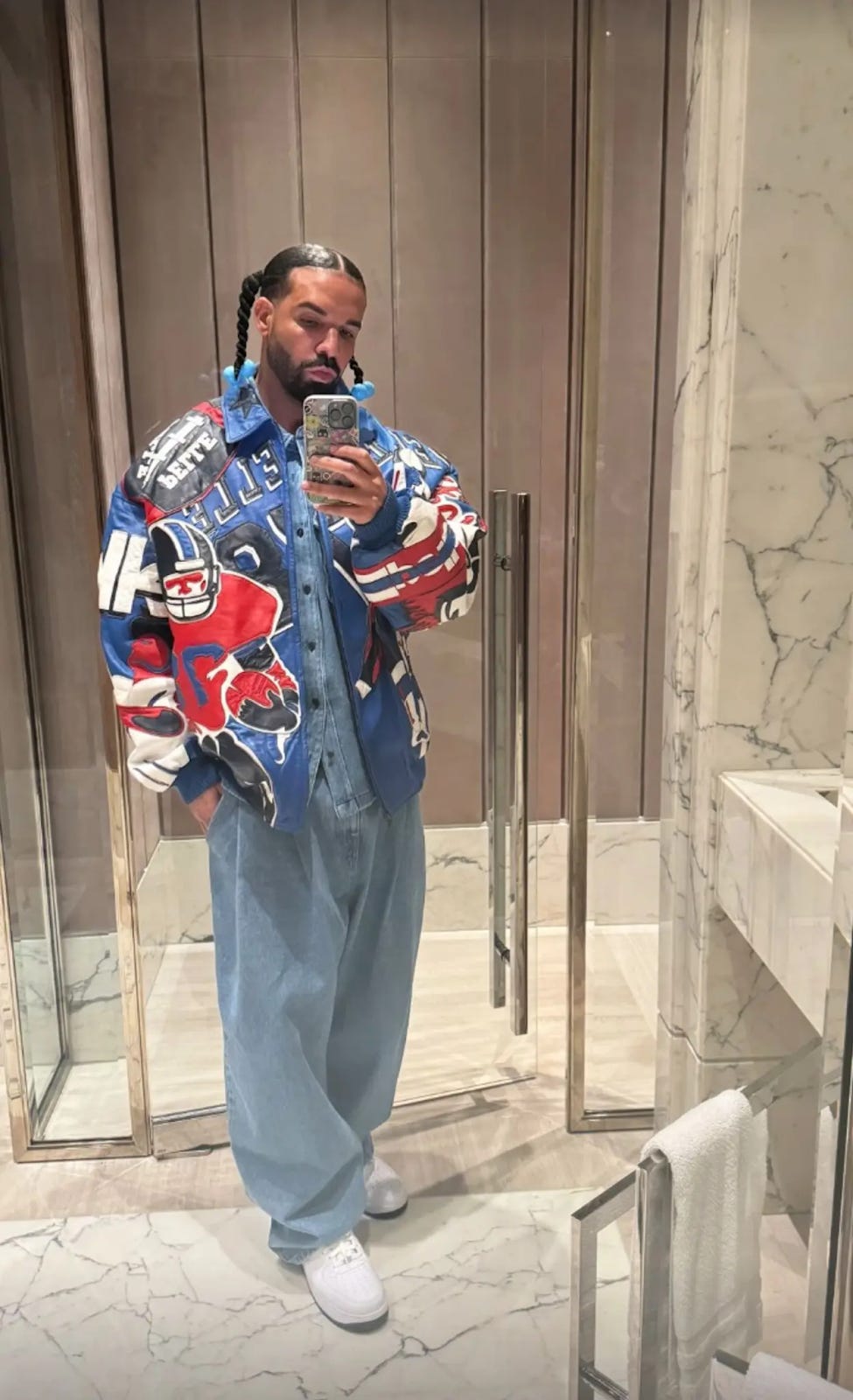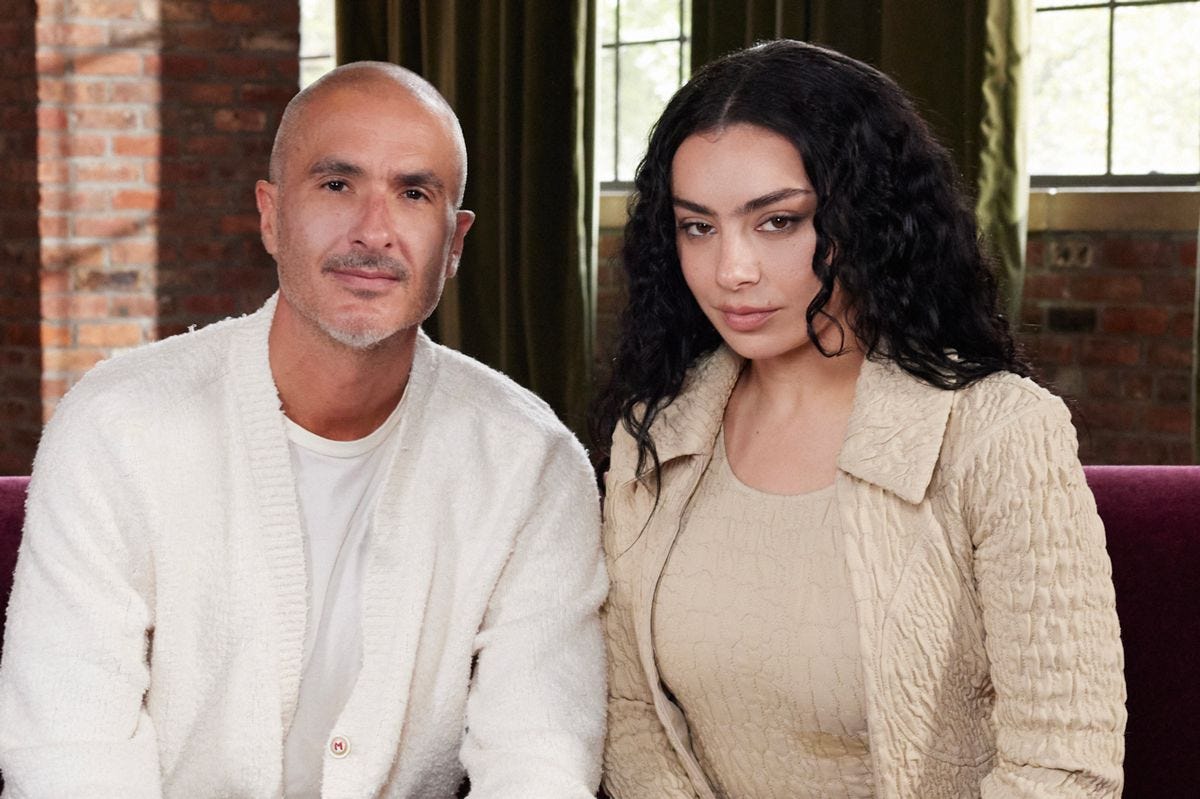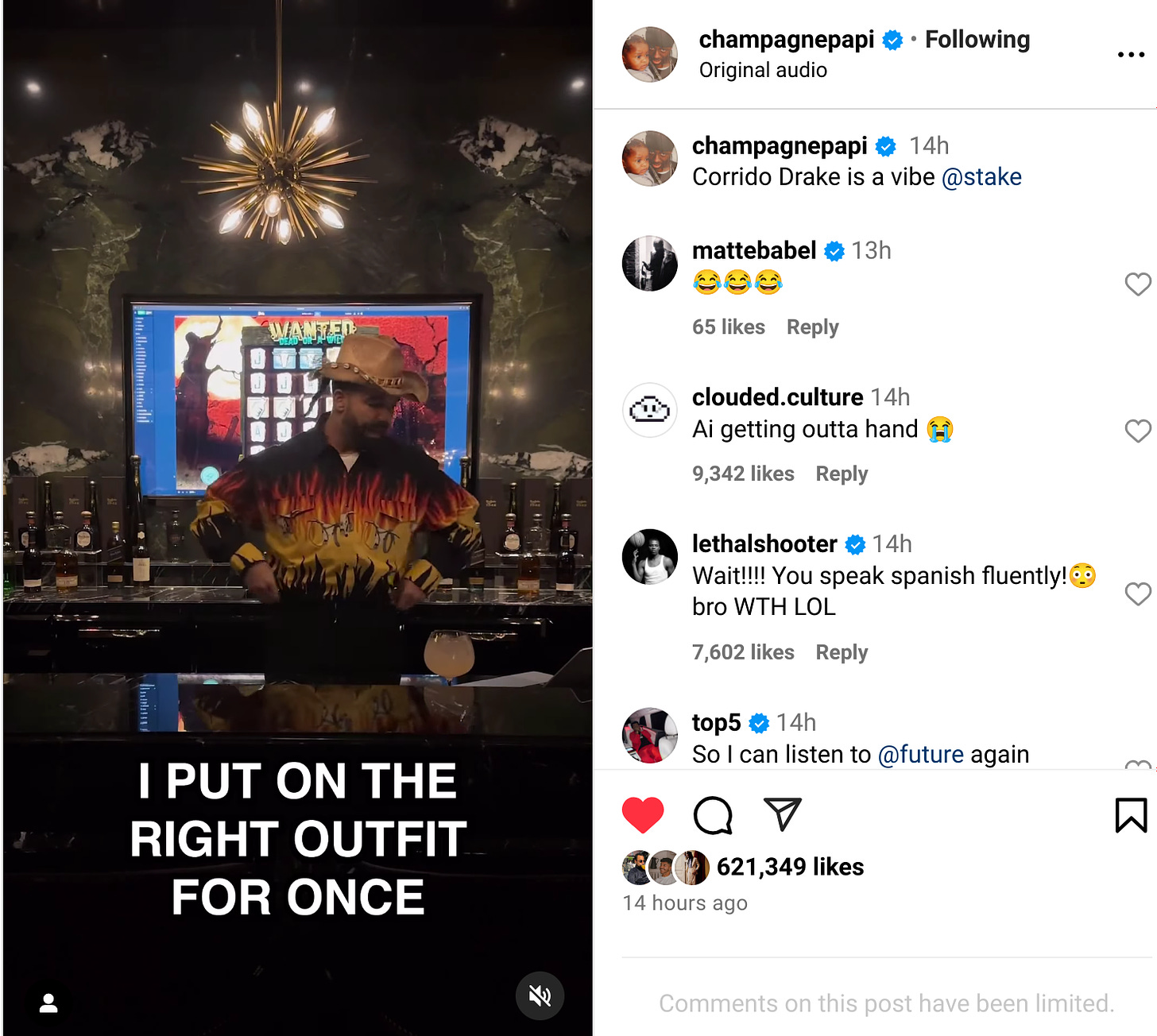The Problem With Going Viral
audience development re: charli, chappell, drake, sally rooney and me

Weird things began to happen after I published an essay on what Mark Zuckerberg was wearing. In a matter of hours, the essay was read by three times the amount of people who typically read my work after the first twenty-four hours of being published. Soon, odd messages began to surface in my inbox. The comment section of the essay became peppered with users without first or last names saying things I did not understand like “normative whiteness” and “gay race commies” and “girls underwear” (no further context provided) and petitioning something called “Conspiracy Realist Educator Activist Truther Organizer Reader Socializer” otherwise known as CREATOR. None of these things had anything to do with what I wrote.
The Instagram and TikTok privacy teams sent me automated messages informing me that someone was trying to break my accounts. A man I’d never met approached me at the park and somehow knew where I lived. And finally, a few days after publication, the owners of the building that I live in sent an email informing residents of a security threat involving an individual breaking in repeatedly to stalk and hide in stairwells in the wee hours of the morning. He was seen with a knife more than once.
Fortunately, the stalker was not after me and is no longer at large. But still, I was on edge, every notification on my phone causing small ripples of anxiety. A friend remarked that I had broken out of my target audience. This was meant to be a good thing but, at the time, I didn’t feel good. I had always wanted to be colossal and knew that I had the potential to be. I still do. But that dance with virality across new audiences brought forward a new type of fear. A fear of being misunderstood.
This summer, fresher voices have risen to the mainstream in pop music. The success of Charli xcx and Chappell Roan have been compared, two ‘left of center’ artists who have found themselves in the center of cultural and commercial breakthroughs. But how they got there could not have been any more different.
Charli xcx describes the mainstream appeal of BRAT, her sixth studio album, as "the opposite of an overnight success story." I am going to be one of those annoying people who will say that I have been a long-time fan of Charli, locking in with the avant-garde sound of her 2017 Pop 2 mixtape. Although Charli’s trajectory has not been a straight line, her focus on making music that delights her and her core fans built an audience that has been groomed to recognize her vision over many years. With the release of BRAT, the singer set out to make something that appealed to this core audience at the risk of rejecting mainstream appeal. In an Apple Music interview with Zane Lowe, a press pitstop that more frequently feels like packaged media placement than critical journalism, she said the following about her audience strategy in regards to BRAT:
“I really was preparing myself for this album to be for my fanbase only and not really break outside the walls of that at all. For it to feel like Pop 2 in the scale of it… I wrote this sorta manifesto [to my label to explain that] this record will have no traditional radio songs because we don’t live in that world now. You, the label, should recognize that. And you should recognize that this fan base that I have built is so hungry for me and my peers and our slightly-left-world-of-pop-dance music to succeed… We just have to do it for them. We have to make them feel so special because they’ve championed us for so long. Now, niche is rewarded so much more than it ever has ever been and labels recognize that.”
For her, the project wasn't about going viral or capturing a mainstream audience. It was about making something for her intended audience, a network of fans who understand the cultural apparatus around her. In the first verse of 360, she opens with "I went my own way and I made it" and she kinda ate with that one. By way of manifestation and hard work, it came true.
Whereas Charli has released six studio albums over a decade, Chappell Roan’s first studio album, which peaked at #2 on the Billboard Hot 200, is only a year old. As a result, there has been considerably less time for her audience to become attuned to her artistic vision and persona. I am not going to regurgitate the various challenges she’s faced with her virality and her push-and-pull relationship with those who call themselves her fans. It’s safe to say that she is still acclimatizing to this newfound success while bearing the weight of parasocial attention. That being said, the step that is missing in her rise is what once-cult-now-mainstream artists like Charli xcx, Lana Del Rey, SZA, and Tyler, The Creator were afforded: audience development. By making art for a niche, contained audience that grew over time, these artists were allowed to experiment (and crash out) under the protective wings of a trusted fan base, further emboldening loyalty and artistic comprehension.
When I hear stories of people “turning” on Ice Spice after a mediocre album or Tommy Richman’s studio album “flopping” after MILLION DOLLAR BABY’s TikTok virality catapulted the song to #2 on the charts, I’m not surprised. There’s a difference between attention and influence. A difference between followers and fans. A difference between someone who comes across my writing and someone who decides to type in their email and hit subscribe. In this new era of entertainment and media consumption, there is too much emphasis on scale and rapid growth at the expense of comprehension and loyalty. Sustainability is an afterthought.
Sustainability is on the mind of Sally Rooney, bestselling author of Conversations with Friends, Normal People, Beautiful World, Where Are You, and now Intermezzo, released last month to great frenzy. Anointed the literary ‘voice of a generation,’ Rooney’s novels investigate relationships through the lens of class, politics, and sex. Known for her bone-dry prose, which mechanically orients the reader through precise scenes with brute objectivity, she offers a canvas for her fans to project their own experiences onto, a style technique that has aroused both praise and skepticism. Despite the gargantuan success achieved over seven years of novel publishing, some say that Rooney writes the same story over and over. That there is little innovation across her plots. And yet, innovation perhaps isn’t her ambition. In an interview with the New York Times, Rooney says that reinvention is not her goal.
“I don’t think about my growth as an artist... There’s a huge cultural fixation with novelty and growth. Our whole economic system is obviously built on constant, permanent, ceaseless growth. We all have to grow. Everything has to grow all the time. Get bigger. Sell more. And be different. Novelty. And… I don’t find that very interesting.”
Rooney claims that she never thinks about her novels in relation to one another or about her body of work as a whole. She’s much more concerned with the individual project of the novel at hand and if that means that she’s applying similar themes across her oeuvre (although she says she never thinks of herself as having one), so be it.
Although Charli xcx and Sally Rooney could not be on further sides of the cultural sphere (“opposite and on the other side” as Charli would say although I’d reckon that Bobbi in Conversations with Friends is brat), they both hit on a similar thing. They both are sustainably developing audiences by remaining consistent in their themes across projects. For Charli, it’s hyper-pop-laced club music and for Rooney, it’s moody introspective relationship studies. Rooney would say that she creates without fan service in mind, an earned privilege of an author whose readership is less like a niche cult and more like a mass religion. She doesn’t fear being misunderstood. But the strategy still holds. Who needs to expand to new audiences when you’ve punctured a core?
An artist that I’m keeping my eye on as he gears up for a comeback is Drake. I have written extensively about the rap beef between Kendrick Lamar and Drake and the power of hatred. What was impressive about the blows issued by Lamar was how he slowly dismantled Drake’s character across an array of diss tracks, disrupting the key foundation of Drake’s image: coming for his softness, his accent switching, and his cultural interloping. As fair game as these subjects are for critique, these are what OG Drake fans fell in love with. But when shit hit the fan this summer, and Lamar became the victor in the public (and commercial and critical) court of opinion, numerous Drake “fans” came out of the woodwork to reveal themselves as haters in a way that is synonymous with the blowback Chappell Roan and Ice Spice received from their fast followers.
I predict that instead of shedding the emblems of embarrassment that Lamar dunked on, Drake will actually celebrate them to double down on the aspects of his artistry that he built his audience on. It is possible that Drake no longer sees the value in being the biggest musician in the world. Sure, he can fill out any stadium but what good is that when you are filling a stadium with people who will flock to the next camp the moment you are down? Money, I guess.
Here’s how I think he’s doing it…
Step 1: Look like yourself and like no one else.

No rapper who is adamant about beating the babygirl allegations would ever show up with their hair did like this. Pippi Longstocking from The Six. By deliberately assembling himself this way, Drake is reflecting the prevailing comedic interpretation of his persona back to us as drag. It’s Chappell’s red hair. It’s Charli’s big black mane of extensions and ripped fishnets. It’s Taylor Swift’s red lips. It’s only when someone can dress up as you for Halloween that you have an iconic image. Let’s see how many trick-or-treaters dress like Drake this year.
Step 2: Lean into your own self-mythology.
If Drake is known (and ridiculed) for speaking in borrowed accents – be it Jamaican Patois, British slang, or AAVE – why not have him learn a new accent? In a new campaign for Stake, a sports betting company, Drake has now picked up Spanglish, trolling the haters but also returning to foundational tenets. ‘Corrido Drake,’ he calls himself.
Step 3: Give fans the you that they originally fell in love with.
On the loosey Circadian Rhythm, Drake returns to the melodic, sing-song rap that introduced a new way of vocal intonation for both pop and rap music collectively. The song is great and the limited promotion of it harkens back to Drake’s “Acura days” of mixtape dropping.
The evidence above indicates that Drake isn’t shying away from the DNA that built his original audience even though it has been clowned by his hip-hop contemporaries. These activities are generating two separate reactions from audiences, emboldening the die-hard fans with this return to form, and serving as additional ammo for those intent on taking him down. I believe this is strategic. He is participating in something called “audience shedding,” a deliberate attempt to lose fans who may not align with your vision so you can focus on the most loyal. In a way, he’s freer for it.
I have spent over a year and a half consistently publishing LOOSEY every other Sunday so it’s surprising to me that the Mark Zuckerberg essay – an individual I rarely think about – is the one that has been read the most. My readership has been growing consistently so it’s not uncommon that each release will eclipse the previous but it’s also the essay that I spent the least amount of time on, its genesis pouring out of me over a few hours. In a way, it’s a LOOSEY staple, mixing various elements across technology and culture to make conclusions about how we live today. Similar to Charli xcx’s BRAT, there wasn’t a grand plan to appeal to the masses but I’m grateful that it did.
The downsides of virality are partially offset with praise, new opportunities, and readership growth (sorry, Rooney — this matters to me). With each essay, I become better and you, the reader, hopefully, get a better sense of what my vibe is and what I’m trying to do here. Some grievances come with increased exposure but, when you do it your own way, you’d be surprised at what can come true.
LOOSEY is a bi-weekly newsletter about culture, technology, and the way we live. If this is something you like, consider subscribing and sharing. Let’s be friends on Instagram.











Really loved this piece!
Another amazing piece! Loved your thoughts on Drake, agreed